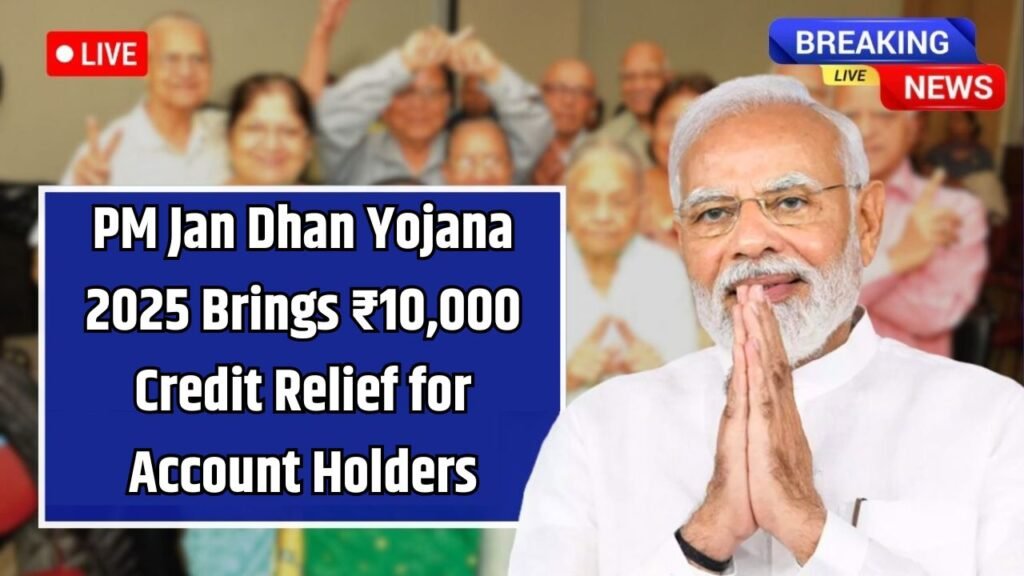The Pradhan Mantri Jan Dhan Yojana (PMJDY), launched in 2014, has played a pivotal role in India’s financial inclusion journey. Over the years, it has enabled millions of previously unbanked citizens to open savings accounts and access core banking services. As of 2025, PMJDY has over 56 crore accounts and total deposits exceeding ₹2.68 lakh crore.
In 2025, the scheme has gained fresh attention with proposals for a ₹10,000 credit facility (or overdraft) for eligible Jan Dhan account holders. Below is an updated, clearer look at this development along with the scheme’s core features.
What Is PMJDY — Core Features & Current Status
Before going into the new credit scheme, here’s a snapshot of what PMJDY offers today:
| Feature | Details / Updates |
|---|---|
| Zero-balance account | No minimum balance required for Basic Savings Bank Deposit Account (BSBDA) accounts. |
| RuPay debit card + insurance | Free RuPay debit card with built-in accident insurance cover of ₹2 lakh. |
| Overdraft facility | Account holders are eligible for an overdraft (credit) of up to ₹10,000 for emergencies. (This is an existing feature, being extended or emphasized further in 2025) |
| Growth & usage | Over 56 crore accounts opened. Average deposit per account ~₹4,768. 67% of accounts in rural/semi-urban areas; 56% held by women. |
| Role in welfare delivery | PMJDY accounts act as conduits for Direct Benefit Transfers (DBT) for many government welfare schemes. |
What’s the ₹10,000 Credit (Overdraft) Scheme in 2025?
What is the new proposal?
While the overdraft facility up to ₹10,000 already exists, recent announcements suggest that in 2025 the government is planning to directly credit ₹10,000 or enable a simplified mechanism for Jan Dhan account holders to access this amount more easily. Some news sources say:
- The credit may be directly credited into accounts, without needing to apply separately.
- No charges may be deducted from this credit.
- Eligibility may require active accounts, KYC, Aadhaar linking, and transactional activity.
Because this is a new announcement (or proposal), full official guidelines are not yet uniformly available.
Who may be eligible?
Possible criteria include:
- Holding an active Jan Dhan account with updated KYC / Aadhaar linkage
- Demonstrating regular transactions or usage
- Having maintained the account for a minimum period
- Preference to low-income families, women, daily wage earners, micro-enterprises
How might the credit work?
- No collateral: The loan is expected to be unsecured
- Quick disbursal: Funds to be transferred rapidly after approval
- Flexible repayment: Likely within 90 days or a short window
- Minimal or no interest: Some sources mention “zero charges” or very low interest
What are the intended benefits?
- Provide emergency financial support (medical, home repairs, business restocking)
- Reduce reliance on informal moneylenders charging exorbitant interest
- Encourage financial discipline through linking credit access to account activity
- Enable Jan Dhan account holders to build credit history gradually
Potential Challenges & Things to Watch Out For
- Ensuring responsible usage and timely repayments is crucial to prevent defaults
- Robust monitoring and fraud prevention mechanisms will be needed
- Many first-time borrowers may need financial literacy support
- Final implementation details (interest rates, repayment period, eligibility criteria) could vary across banks and may change over time
PM Jan Dhan Yojana 2025
Launched in 2014, the Pradhan Mantri Jan Dhan Yojana (PMJDY) has long been the flagship of India’s financial inclusion drive. It has enabled millions of previously unbanked individuals to open zero-balance savings accounts, receive RuPay debit cards with insurance cover, and access overdraft facilities. Over time, it became the backbone for distributing government subsidies directly through Direct Benefit Transfers (DBT).
As of mid-2025, the scheme boasts over 56.16 crore accounts with total deposits of approximately ₹2.68 lakh crore. Around 67% of accounts are in rural or semi-urban areas, and 56% of them are held by women—underscoring the scheme’s reach among underserved segments.
The 2025 Credit Push: ₹10,000 Overdraft / Direct Credit
In 2025, the government has proposed a strengthened credit component under PMJDY: enabling Jan Dhan account holders to access ₹10,000 in credit or overdraft, with more streamlined procedures. Some reports suggest this could even be credited directly into accounts, without needing separate applications.
This new proposal builds on the existing overdraft provision of up to ₹10,000, aiming to simplify access, reduce friction, and extend support especially in emergencies.
Key elements (expected/proposed):
- No collateral requirement
- Fast approval and disbursal
- Flexible repayment window (e.g. ~90 days)
- Minimal or no interest/charges
- Tied to account activity / usage
The goal is to offer a formal credit option to those who typically rely on informal, high-interest lenders—such as small vendors, daily wage earners, or micro-entrepreneurs.
Who Stands to Benefit?
The scheme particularly targets those who:
- Maintain an active Jan Dhan account with updated KYC
- Have a track record of transactions
- Belong to low-income households, especially women and micro-business owners
Advantage Highlights
- No Collateral Overcome: Removes a big hurdle for people lacking assets
- Quick Access to Funds: Vital in emergencies or business needs
- Encourages Good Banking Habits: Regular account usage could improve eligibility
- Reduces Informal Debt: Cuts dependence on local lenders charging steep rates
Implementation & Risks
- Banks must implement efficient approval systems and risk checks
- Financial literacy must be ramped up so borrowers understand terms
- Default risk must be managed carefully
- Variations across banks must be minimized so benefits are uniform
Final Thoughts
This ₹10,000 credit initiative under PMJDY 2025 is a welcome evolution—not just saving, but empowering through accessible credit. If executed well, it can help millions build a credit footprint and gradually gain access to more sophisticated financial products. It has the potential to further strengthen financial inclusion, stimulate grassroots enterprise, and support vulnerable households.
However, the success depends heavily on clear guidelines, reliable implementation, strong oversight, and borrower education. As more official details emerge, Jan Dhan account holders should stay informed, maintain active accounts, and complete all required KYC updates to leverage this opportunity.
Disclaimer
This is for general informational purposes only. Check with your bank or official sources for accurate, up-to-date eligibility rules, interest rates, and process details.








